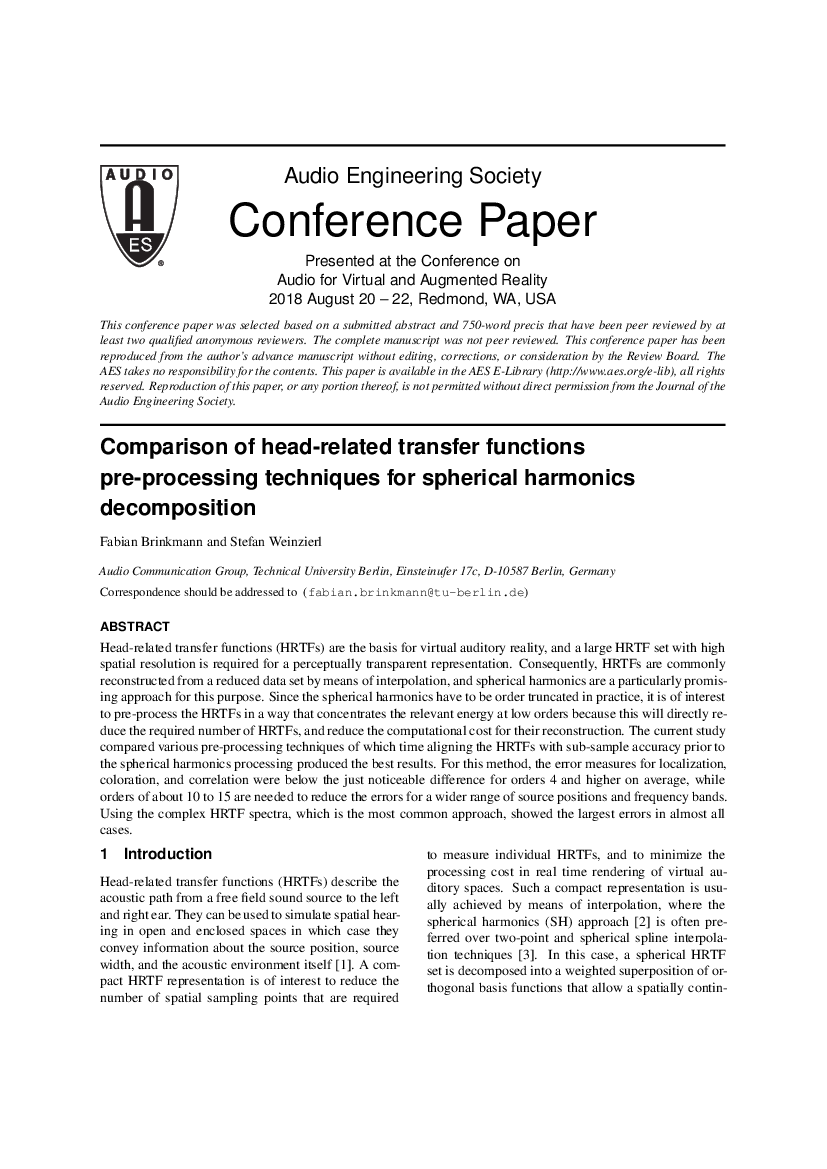Home / Publications / E-library page
You are currently logged in as an
Institutional Subscriber.
If you would like to logout,
please click on the button below.
Home / Publications / E-library page
Only AES members and Institutional Journal Subscribers can download
Head-related transfer functions (HRTFs) are the basis for virtual auditory reality, and a large HRTF set with high spatial resolution is required for a perceptually transparent representation. Consequently, HRTFs are commonly reconstructed from a reduced data set by means of interpolation, and spherical harmonics are a particularly promising approach for this purpose. Since the spherical harmonics have to be order truncated in practice, it is of interest to pre-process the HRTFs in a way that concentrates the relevant energy at low orders because this will directly reduce the required number of HRTFs, and reduce the computational cost for their reconstruction. The current study compared various pre-processing techniques of which time aligning the HRTFs with sub-sample accuracy prior to the spherical harmonics processing produced the best results. For this method, the error measures for localization, coloration, and correlation were below the just noticeable difference for orders 4 and higher on average, while orders of about 10 to 15 are needed to reduce the errors for a wider range of source positions and frequency bands. Using the complex HRTF spectra, which is the most common approach, showed the largest errors in almost all cases.
Author (s): Brinkmann, Fabian; Weinzierl, Stefan
Affiliation:
Technical University of Berlin, Berlin, Germany
(See document for exact affiliation information.)
Publication Date:
2018-08-06
Import into BibTeX
Permalink: https://aes2.org/publications/elibrary-page/?id=19683
(1128KB)
Click to purchase paper as a non-member or login as an AES member. If your company or school subscribes to the E-Library then switch to the institutional version. If you are not an AES member Join the AES. If you need to check your member status, login to the Member Portal.

Brinkmann, Fabian; Weinzierl, Stefan; 2018; Comparison of Head-Related Transfer Functions Pre-Processing Techniques for Spherical Harmonics Decomposition [PDF]; Technical University of Berlin, Berlin, Germany; Paper P9-3; Available from: https://aes2.org/publications/elibrary-page/?id=19683
Brinkmann, Fabian; Weinzierl, Stefan; Comparison of Head-Related Transfer Functions Pre-Processing Techniques for Spherical Harmonics Decomposition [PDF]; Technical University of Berlin, Berlin, Germany; Paper P9-3; 2018 Available: https://aes2.org/publications/elibrary-page/?id=19683
@article{brinkmann2018comparison,
author={brinkmann fabian and weinzierl stefan},
journal={journal of the audio engineering society},
title={comparison of head-related transfer functions pre-processing techniques for spherical harmonics decomposition},
year={2018},
number={P9-3},
month={august},}